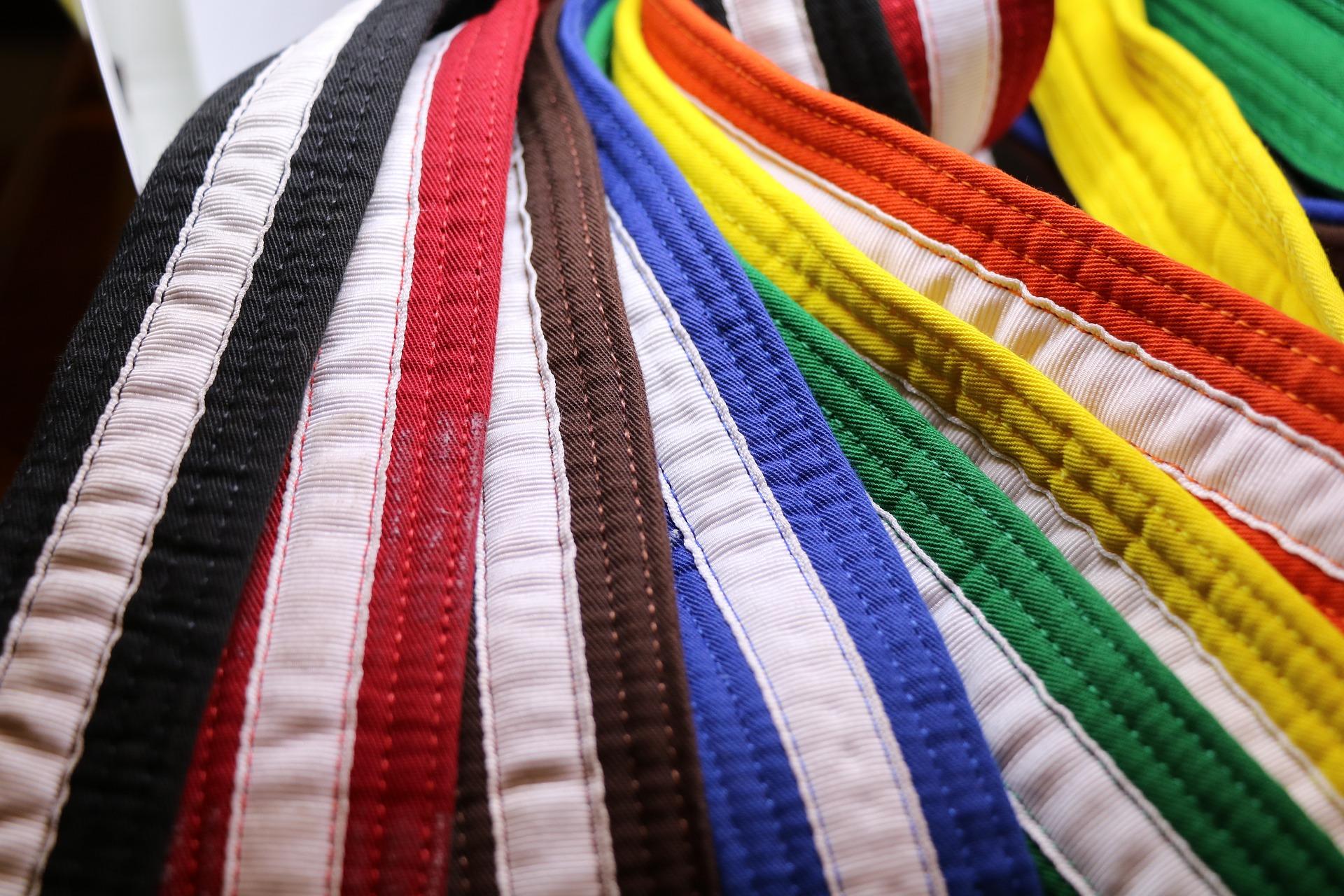What does it mean to achieve the highest belt in martial arts?
Even if you have never stepped foot into a martial arts training institution, you are likely aware of the different belt colours or have heard others praising athletes for making it to the black belt level. What do all these various coloured belts mean anyway, and how is it significant to taekwondo?
For a combat sport that is fairly young in its history, it's amazing that taekwondo is one of the martial art forms widely practised around the world today. You could be thinking of getting into this popular sport, so let's see what's in store for when you obtain your first white belt.

What is the history of taekwondo belts?
The early years of taekwondo didn't have any ranking system or belts that students could earn.
It was actually the creator of judo, Kanō Jigorō, who introduced belts into the modern martial arts system. Kanō was inspired by go, a Japanese board game, when he created his belt system in the early 20th century. At the start, only the colours white and black were used: a white belt represented a student who was in the process of learning the basics of judo.
A black belt meant that the individual had mastered the basics and was ready to pursue an advanced level of martial arts.
Other colours like blue and brown were later introduced into the system, and soon other martial art forms favoured the idea of being able to easily identify students' level of mastery alongside helping these students progress in the arts. Following the evolution of this belt system, standardised taekwondo belts were introduced in South Korea around the middle of the 20th century, before spreading to other parts of the world.

What is the highest belt you can get in taekwondo?
Taekwondo belts are divided into two categories, namely "junior" and "senior" belts. Junior belts are coloured belts, including white, yellow, green, blue and red belts - with the white belt representing students who have just begun their journey in taekwondo. There are generally ten of these junior belts, although the number may vary between eight to 12 belts depending on the governing organisation.
Junior levels in taekwondo are called Geup whereas senior levels are called Dan.
At the senior level, you are no longer a student but a master of martial arts. Therefore, all the belts at the senior level are black, with the 9th Dan, or ninth degree black belt being the highest belt that you can get in taekwondo. When you've reached the highest degree in taekwondo, you are considered a grandmaster in the combat sport.
How well do you know the famous practitioners of taekwondo?
Before obtaining the highest belt in taekwondo, you will need to successfully master eight different levels of Dan. If you possess a black belt in taekwondo, you are qualified to teach the martial arts to others as you have reached a certain level of mastery and maturity in the sport. On the other hand, you could say that the junior belts serve to track your progress in taekwondo.
The table below is a summary of the names of taekwondo belts and their colours, as well as what they indicate in terms of your mastery level according to the International Taekwondo Federation (ITF). Remember that the taekwondo belts will differ based on which organisation you are following, such as if you are learning under the World Taekwondo (WT) system.
| Name of Taekwondo Belt | Belt Colour | Level of Mastery |
|---|---|---|
| 10th Geup | White | Beginner |
| 9th Geup | White with yellow stripe | Beginner |
| 8th Geup | Yellow | Beginner |
| 7th Geup | Yellow with green stripe | Beginner |
| 6th Geup | Green | Intermediate |
| 5th Geup | Green with blue stripe | Intermediate |
| 4th Geup | Blue | Intermediate |
| 3rd Geup | Blue with red stripe | Advanced |
| 2nd Geup | Red | Advanced |
| 1st Geup | Red with black stripe | Advanced |
| 1st Dan | Black with yellow stripe | Beginner black belt |
| 2nd Dan | Black with two yellow stripes | Assistant instructor |
| 3rd Dan | Black with three yellow stripes | Assistant instructor |
| 4th Dan | Black with four yellow stripes | Instructor |
| 5th Dan | Black with five yellow stripes | Master |
| 6th Dan | Black with six yellow stripes | Master |
| 7th Dan | Black with seven yellow stripes | Master |
| 8th Dan | Black with eight yellow stripes | Master |
| 9th Dan | Black with nine yellow stripes | Grandmaster |

What do the colours of taekwondo belts mean?
Now you know that the coloured belts in taekwondo, excluding the black belt, represent students who are at the beginner to advanced level of the sport. The colours of these junior-level belts vary from organisation to organisation, as well as the requirements for advancing in the taekwondo belts.
We're going to introduce some coloured belts you may have seen if your institution is following the WT system, and not the ITF system. This is not an exhaustive list of items you should check off at each belt level, but it should give you an idea of the level of skill that is expected!

Orange Belt
At the orange belt level, you would have already attained your white and yellow belts. At this stage, you will learn the Taeguk Ee Jang form, the second of eight taekwondo forms practised by WT. You will learn to develop skills such as the trap back kick, high punch and middle block.
Purple Belt
The purple belt means you have passed your white, yellow, orange, green and blue belts. You would have acquired the foundational knowledge of the combat sport by this point, and the form you will work on is known as the Taeguk Sa Jang - representing a pious yet dignified mental state. The roundhouse kick, hook punch and single knife-hand block are some techniques you will develop.
Brown Belt
Taeguk Yuk Jang is the form to be practised at the brown belt level, and you are now two belts away from the black belt level. You will begin combining some of the techniques you have learned in previous levels, as well as build on intermediate and advanced-level taekwondo skills.
Think of the numerous benefits you can get from learning taekwondo!
What are the taekwondo black belt levels?
You may be wondering why black is the chosen colour for the highest belt in taekwondo.
For taekwondo belts, black is considered the opposite of white, so it represents an individual's maturity and proficiency in the combat sport. However, it can also be considered a combination of all the coloured belts mixed together, which goes to show one's mastery of all previously learned forms and techniques.
Black in taekwondo also represents one's immunity to fear.
Did you know that you cannot take a test for a black belt if you have not yet reached the age of 15?
At least, that's what will happen if you are following the WT system. Instead of the Dan level, the black belt ranks for children are known as Poom, which are further broken down into four grades. Upon reaching 15 years of age, the student who is in the Poom grade can be changed to a Dan grade without any additional testing.
To achieve the highest belt in South Korea, or any part of the world where you are learning taekwondo, you will need skill, discipline, perseverance and dedication to the martial arts. Getting the 1st Dan will take you a minimum of 2 years, and moving up to the next black belt level will take you several years as well.
Here's a summary of the black belt levels in taekwondo and the minimum age requirements:
| Taekwondo Black Belt | What It Means | Minimum Age to Test |
|---|---|---|
| 1st Dan | You can teach younger students and those at the white belt level as you are now considered a senior. | 15 years |
| 2nd Dan | As an assistant instructor, you will teach older and more advanced students under the guidance of a Master. | 18 years |
| 3rd Dan | You are a senior assistant instructor with advanced black belt level training. | 21 years |
| 4th Dan | You are an instructor at the level of Associate Master, having qualifications to lead black belts up until the 1st Dan and you can also start your own school. | 25 years |
| 5th Dan | You have made multiple contributions to taekwondo and your organisation. You can also promote black belts to higher levels. | 30 years |
| 6th Dan | In addition to your own training, your focus is to teach other instructors. | 30 years |
| 7th Dan | You are considered a Master of the martial arts at this level. You will also be under constant supervision of an 8th or 9th Dan Master. | 30 years |
| 8th Dan | As one of highest belts, you will have taken an average of 40 years to reach this level, with strong devotion to the martial arts. | 53 years |
| 9th Dan | As the highest black belt rank, you have shown incredible devotion to the arts, demonstrated consistent training and in service to the board of organisations in taekwondo. | 53 years |

How do you move up belts in taekwondo?
It's a common goal to improve your status as a taekwondo athlete and move up the ranking system. So how do you get yourself promoted?
Generally, a student will be invited by their instructor to participate in a belt promotion test. This invitation is usually given ahead of the actual test so that the student will have time to prepare or focus on specific moves and tasks that will be assessed. You will spend most of your time enhancing certain areas of the combat sport before your test.
Be prepared for areas such as physical exercise, poomsae or taekwondo forms, sparring, and even written tests that will ask you about the fascinating history of taekwondo.
If your progress has been approved by your instructor, then congratulations on moving up the taekwondo belts! If you didn't get the highest belt this time around, know that you have room to improve and can still take the test another time.
Take lessons with a Superprof taekwondo coach if you want to improve in the martial arts.
Learning from a certified taekwondo coach can be expensive, but you can take quality taekwondo lessons for under RM50 when you sign up with Superprof. Did you know that you can find taekwondo masters who have spent decades learning the sport at Superprof? You don't have to break the bank to become a black belt holder in taekwondo.
Another benefit you can get with Superprof is attending your taekwondo lessons via webcam, which means you can improve your techniques from the comfort of your home. Whether you want to learn one-to-one or take group classes with your friends who are also interested in taekwondo, the choice is yours to create your preferred learning environment.
Still, if you're unsure whether your taekwondo master on Superprof is right for you, we are happy to share that you can try your first taekwondo lesson for free. Begin today and become a certified black belt in taekwondo!
















